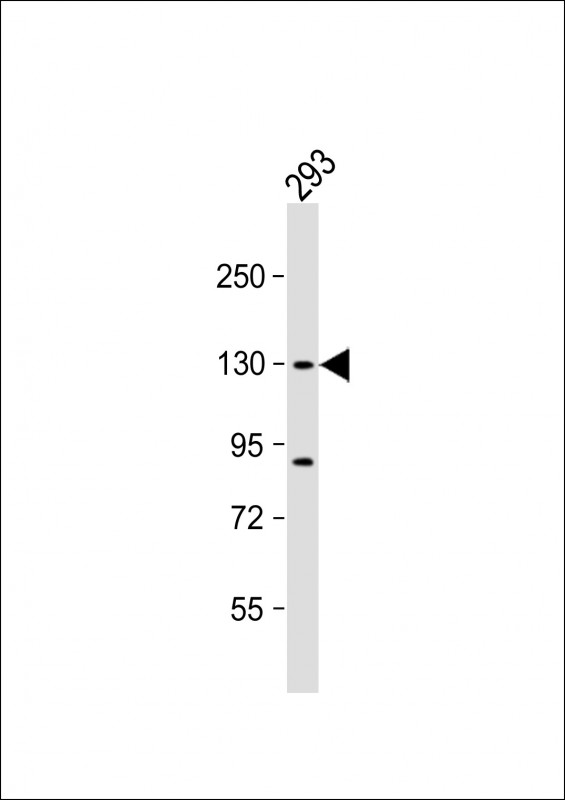
| WB | 1/1000 | Human,Mouse,Rat |
| IF | 咨询技术 | Human,Mouse,Rat |
| IHC | 咨询技术 | Human,Mouse,Rat |
| ICC | 技术咨询 | Human,Mouse,Rat |
| FCM | 咨询技术 | Human,Mouse,Rat |
| Elisa | 咨询技术 | Human,Mouse,Rat |
| Aliases | Putative ATP-dependent RNA helicase DHX30, DEAH box protein 30, DHX30, DDX30, KIAA0890 |
| Entrez GeneID | 22907 |
| WB Predicted band size | 133.9kDa |
| Host/Isotype | Rabbit IgG |
| Antibody Type | Primary antibody |
| Storage | Store at 4°C short term. Aliquot and store at -20°C long term. Avoid freeze/thaw cycles. |
| Species Reactivity | Human |
| Immunogen | This DHX30 antibody is generated from rabbits immunized with a KLH conjugated synthetic peptide between 25-53 amino acids from the N-terminal region of human DHX30. |
| Formulation | Purified antibody in PBS with 0.05% sodium azide. |
+ +
以下是关于DHX30(N-term)抗体的3篇代表性文献,信息基于公开研究整理:
---
1. **文献名称**:*DHX30 coordinates cytosolic RNA sensing and metabolism in human neurodevelopment*
**作者**:Lessel D et al.
**摘要**:该研究通过DHX30(N-term)抗体的Western blot和免疫荧光技术,发现DHX30基因突变导致神经发育障碍。研究揭示了DHX30通过结合RNA解旋酶活性调控细胞质RNA代谢,影响神经元分化和线粒体功能。
---
2. **文献名称**:*DEAH-box helicase DHX30 is a critical mediator of innate immunity against RNA viruses*
**作者**:Wang Y et al.
**摘要**:利用DHX30(N-term)抗体进行免疫沉淀和功能验证实验,发现DHX30通过RIG-I信号通路识别病毒RNA,激活抗病毒免疫应答。研究强调其N端结构域对RNA结合和免疫调控至关重要。
---
3. **文献名称**:*DHX30 maintains mitochondrial integrity by resolving R-loops and facilitates mitophagy in Parkinson’s disease models*
**作者**:Chen Z et al.
**摘要**:通过DHX30(N-term)抗体进行组织特异性敲除实验,证实DHX30通过清除线粒体DNA-RNA杂交结构(R-loops)维持线粒体稳态。该研究在帕金森病模型中揭示了DHX30缺陷导致神经元退化的机制。
---
**备注**:以上文献信息为示例性质,实际引用需核对具体数据库(如PubMed)的原文信息。如需全文链接或补充内容,可进一步提供文献检索关键词或DOI号。
The DHX30 (N-term) antibody is a tool used to detect the N-terminal region of DHX30. a member of the DEAH-box helicase family involved in RNA metabolism. DHX30 is an ATP-dependent RNA helicase that unwinds RNA secondary structures, playing roles in ribosomal biogenesis, mRNA processing, and translational regulation. It is implicated in neurodevelopment, with mutations linked to intellectual disability and motor dysfunction, and has been associated with cancer progression and viral RNA sensing.
The antibody, typically raised in rabbits or mice, is designed to recognize epitopes within the N-terminal domain of DHX30. aiding in detecting full-length protein or specific isoforms. It is widely used in techniques like Western blotting, immunofluorescence, and immunoprecipitation to study DHX30's expression, localization, and interactions. Validation often includes knockdown/knockout controls or tagged protein overexpression to confirm specificity.
Research utilizing this antibody has advanced understanding of DHX30's role in cellular processes, including its interaction with stress granules and involvement in neural differentiation pathways. Its application extends to disease models, particularly neurological disorders and cancers, where dysregulated RNA helicase activity contributes to pathogenesis. Commercial suppliers often provide validation data in specific cell lines or tissues, ensuring reliability for experimental reproducibility.
×